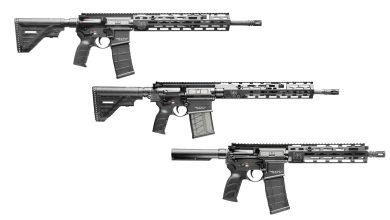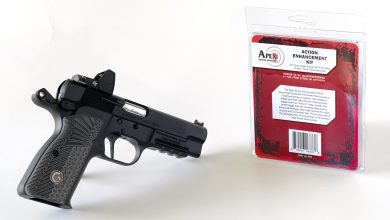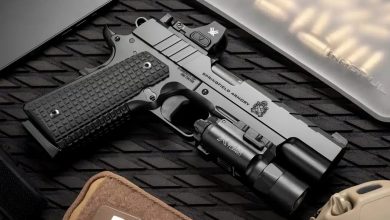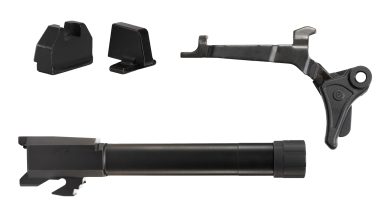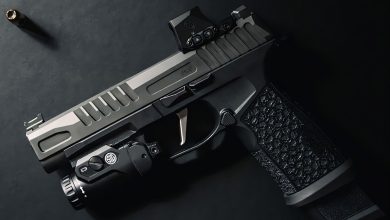Review: Steiner MPS Red Dot Sight
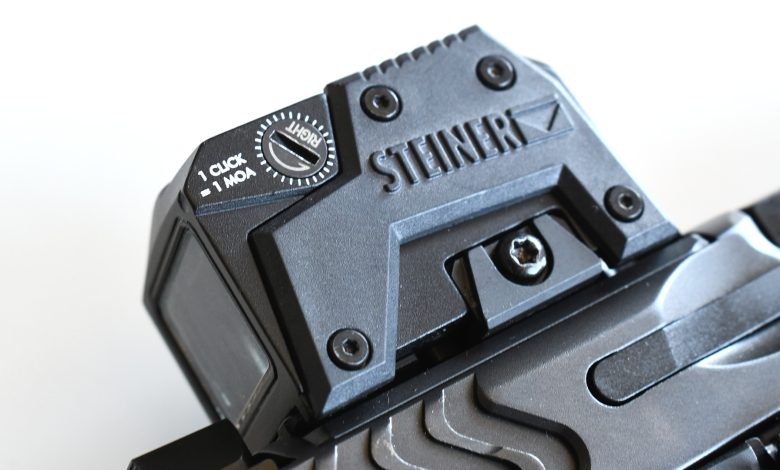
Throughout the last few months, enclosed-emitter reflex sights have been in my pistol-shooting purview. The Steiner MPS (Micro Pistol Sight), a dedicated duty-grade, enclosed-emitter red-dot sight, has been one of the models I’ve been working with, especially since I took possession of a Smith & Wesson M&P9 M2.0 Metal Carry Comp pistol to shoot and review. As I am writing this during the tail end of October, this particular pistol and dot combination have seen nearly 1,000 rounds together. I’ve already written about my experiences with the M&P9 M2.0 Metal Carry Comp, so I wanted to share my thoughts on the Steiner MPS.
Steiner MPS Overview
The Steiner Micro Pistol Sight has an MSRP of $632 and was designed for hard use, relying on an enclosed-emitter to beam a 3.3-MOA dot to its objective lens. It’s designed to use space efficiently, as both its emitter array and battery tray are located on the top portion of the MPS’ external housing. This placement allows the optic to have a fairly wide 21mm x 16mm objective lens. Steiner MPS glass can be very easy to take for granted, as it’s quite clear when looking through it without any image distortion. This red-dot sight also has some unique quirks to benefit it as a hard use piece of kit. For example, its housing is flanked by built in “armor” on either side. And the top front edge of the external housing has a bevel to protect the objective lens from impact. Moreover, the objective lens itself slopes in the opposite direction as another means of protection. Furthermore, because the lens slopes “backward” it’s nigh impossible to catch a “false” dot from bright overhead sunlight (as can happen with many other makes and models whose lenses slope forward). At 2.05 ounces and 1.89 inches in length, the MPS hits a sweet-spot in size, especially for tactical/duty type handguns for which Steiner designed the MPS.
A pair of ruggedized rubber buttons are found on the unit’s left side, and besides brightness adjustment, these buttons are also used to control the MPS’ electronic settings such as brightness, on/off and reticle “locking”. Besides the buttons, the only other interfaces the Steiner MPS uses are its windage and elevation adjustment wheels. These are calibrated for the standard “1 click = 1 MOA” adjustments; they’re tactile and easy to click.
The MPS draws power from a single CR1632 battery with a 13,000-hour life, and as previously mentioned, its battery tray sits on the top and is easy to access. The MPS uses the Aimpoint ACRO footprint which is radically different for nearly every other mounting standard for micro reflex sights. Instead of two screws that fasten from the top, sights that use the ACRO standard rely on a single horizontal screw and clamping plate, not unlike most Picatinny-rail based accessories.
Steiner MPS Practical Experiences
I mounted the Steiner MPS to the Smith & Wesson M&P9 M2.0 Metal Carry Comp using an Apex Tactical ACRO/MPS optics plate that mates to the Smith’s factory CORE slide cut. In addition to the plate, I included the Apex Tactical “Super Clamp”, which replaces the OEM Steiner MPS clamp to provide more “bite” or clamping force over the area where the sight sits.
In addition to shooting this red-dot and pistol combination for their respective reviews and my firearms writing work, I attended Greybeard Actual’s handgun class, Pistol Skill Development, and ran the M&P Carry Comp and the Steiner MPS hard: I fired 653 rounds in one day. If the pistol or red-dot would have had any malfunction gremlins, it would have been during this course, but nothing materialized.
The Takeaway
From a shooting perspective, the widescreen objective lens is nice and “comfortable” to use, but the top-loading battery tray means that the upper edge of the sight picture can feel a little clunky when shooting. If one’s dot presentation isn’t uniform, it’s easy to lose the dot over this thicker top edge. I experienced the same issue when shooting with the Trijicon RCR, but I found it to be less pronounced with the Steiner MPS. Although it’s not really a complaint per-se, one of the issues that seems to come up with the Steiner MPS is that it doesn’t always “clamp” over all ACRO footprint pattern surfaces correctly. A good way to overcome this (and cheap insurance) is to use the Apex Tactical Super Clamp mentioned above. Even after that long weekend shooting class, the Super Clamp didn’t budge at all.
Read the full article here


